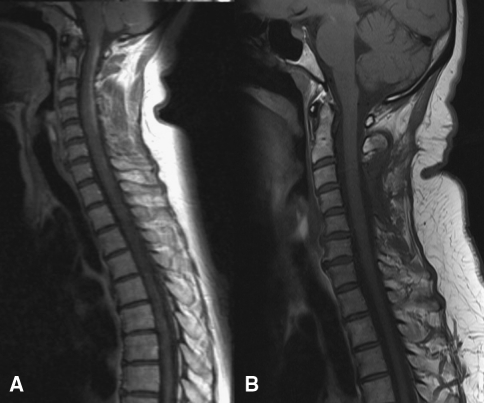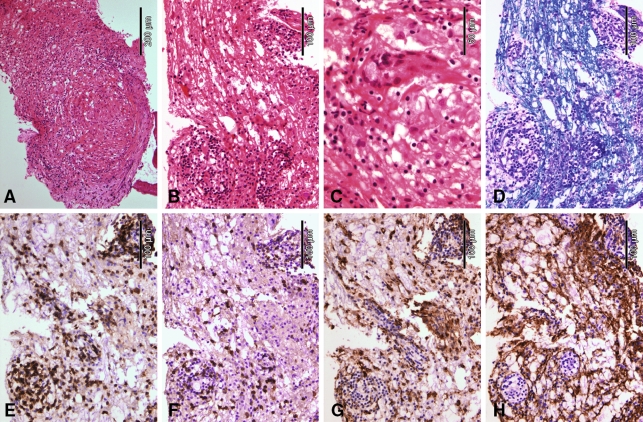Dear Sirs,
We report the rare case of a primary angiitis of the CNS (PACNS) with isolated spinal cord manifestation. This 44-year-old female presented diffuse dysesthesia with moderate progressive weakness of the lower limbs. There were no cerebral symptoms; cMRI was normal. The diagnosis of PACNS was made by a spinal cord biopsy demonstrating granulomatous vasculitis. The patient was successfully treated with steroids and methotrexate. During a 2 year follow-up our patient did not show any brain or other organ involvement.
The 44-year-old female presented with moderate progressive weakness of both legs and burning sensory symptoms of all limbs and the trunk. In addition to moderate paraparesis, the physical examination revealed a moderate pallhypesthesia of the legs with reduced vibratory sense and a diffuse hyp- and dysesthesia below the level of CD5. The family history was unremarkable for neurological diseases.
The MRI of the cervical spine showed a gadolinium-enhancing lesion in the posterior part of the myelon with intramedullary edema. This lesion extended from cervical vertebral bodies 2–7 (Fig. 1a).
Fig. 1.
a MR study of the untreated patient. Sagittal FSE T1-weighted image shows a big, homogeneously enhancing lesion located in the cervical cord. b Follow-up MR study 24 months later. Sagittal FSE T1-weighted image shows no evidence of contrast enhancement of the cervical cord
The cerebral MRI and visual evoked potentials were entirely normal, the examination of the CSF revealed a slight pleocytosis (12 cells/mm3), cytological examination showed regular cells. Oligoclonal bands were absent which makes multiple sclerosis highly improbable.
Laboratory examinations did not reveal any evidence for either metabolic (vitamin-B12, folate), autoimmune or infectious disorder. We found no aquaporin-4-antibodies. With normal VEP, we had no evidence for neuromyelitis optica.
We started with intravenous high dose methylprednisolone therapy (1 g for 5 days), but symptoms relapsed after 3 months of disease freedom.
Before introduction of another immunosuppressive therapy, and to exclude a spinal lymphoma, a biopsy of the spinal lesion was taken. The neuropathological examination revealed a granulomatous vasculitis with transmural inflammation consisting of lymphocytes, epitheloid cells and giant cells (Fig. 2a–h). There was no evidence for systemic organ involvement assessed by thoracic and abdominal computer tomography.
Fig. 2.
The histological features of primary spinal vasculitis. The neuropathological examination revealed vascular thrombosis (a 100× magnification, H&E staining) and vessel walls with transmural infiltration mainly consisting of several lymphocytes (b 200× magnification, H&E staining). In addition, there were epitheloid cells and giant cells (c 400× magnification, H&E staining) which are characteristic for a granulomatous vasculitis. There was no evidence for demyelination (d 200× magnification, LFB-PAS staining). Immunostainings indicated that the vessel walls were mainly infiltrated by CD3-positive T cells (e 200× magnification, immunohistochemistry for CD3) that were partly CD8-positive cytotoxic T cells (f 200× magnification, immunohistochemistry for CD8). Furthermore, several CD68-positive macrophages and activated microglial cells were detectable (g 200× magnification, immunohistochemistry for CD68). Within the CNS tissue, many reactive astrocytes could be observed (h 200× magnification, immunohistochemistry for glial fibrillic acidic protein)
Treatment was started with methotrexate (20 mg/week) combined with prednisolone (tapered from 80 to 10 mg/d within 6 weeks).
Neurological examination at 3 month intervals revealed normal findings except a slight dysesthesia in the legs.
A follow-up MRI after 24 months of treatment demonstrated an obvious regression of the signal intensities within the cervical cord (Fig. 1b), whereas the cMRI remained normal.
Spinal symptoms are a rare presentation of primary CNS vasculitis [1]. The previously reported cases with spinal cord involvement also showed progressive paraparesis and dysesthesia as the most common clinical symptoms [2]. However, usually these symptoms occur in the course of the disease and not at disease onset as in our case. A review of the literature showed only eight cases with initially pure spinal cord involvement [3]; half of these cases developed brain lesions later on [1, 4].
The stereotactic biopsy remains the gold standard to assure the diagnosis of a CNS vasculitis [5], but the diagnosis in daily clinical routine is often only based on clinical and imaging findings as well as the response to treatment. This might be a potential reason for overdiagnosing PACNS in clinical routine. As illustrated by our case, histological verification is crucial for the diagnosis.
The standard therapy for PACNS consists of corticosteroids (1 mg/kg prednisolone) and pulsed cyclophosphamide (0.5 mg/kg). The treatment with cyclophosphamide can have severe side effects [6]. Monotherapy with steroids leads to higher recurrence rates [7]. Since methotrexate has been successfully used in systemic vasculitis [8], we started treatment with a combination of steroids and methotrexate. Our patient reached remission within 3 months and remains stable now more than 2 years later. In biopsy-proven PACNS of the spinal cord, methotrexate seems to be an effective and less toxic alternative to cyclophosphamide.
References
- 1.Salvarani C, Brown RD, Jr, Calamia KT, Christianson TJ, Huston J, III, Meschia JF, Giannini C, Miller DV, Hunder GG. Primary CNS vasculitis with spinal cord involvement. Neurology. 2008;70:2394–2400. doi: 10.1212/01.wnl.0000314687.69681.24. [DOI] [PubMed] [Google Scholar]
- 2.Campi A, Benndorf G, Martinelli V, Terreni MR, Scotti G. Spinal cord involvement in primary angiitis of the central nervous system: a report of two cases. AJNR Am J Neuroradiol. 2001;22:577–582. [PMC free article] [PubMed] [Google Scholar]
- 3.Yoong MF, Blumbergs PC, North JB. Primary (granulomatous) angiitis of the central nervous system with multiple aneurysms of spinal arteries. Case report. J Neurosurg. 1993;79:603–607. doi: 10.3171/jns.1993.79.4.0603. [DOI] [PubMed] [Google Scholar]
- 4.Yuen RW, Johnson PC. Primary angiitis of the central nervous system associated with Hodgkin’s disease. Arch Pathol Lab Med. 1996;120:573–576. [PubMed] [Google Scholar]
- 5.Kim JY, Ahn KJ, Jung JI, Jung SL, Kim BS, Hahn ST. Imaging findings of central nervous system vasculitis associated with Goodpasture’s Syndrome: a case report. Korean J Radiol. 2007;8:545–547. doi: 10.3348/kjr.2007.8.6.545. [DOI] [PMC free article] [PubMed] [Google Scholar]
- 6.Anderson D, Bishop JB, Garner RC, Ostrosky-Wegman P, Selby PB. Cyclophosphamide: review of its mutagenicity for an assessment of potential germ cell risks. Mutat Res. 1995;330:115–181. doi: 10.1016/0027-5107(95)00039-l. [DOI] [PubMed] [Google Scholar]
- 7.Moore PM. Vasculitis of the central nervous system. Curr Rheumatol Rep. 2000;2:376–382. doi: 10.1007/s11926-000-0036-4. [DOI] [PubMed] [Google Scholar]
- 8.Yazici Y. Systemic vasculitis treatment and monitoring update, 2008. Bull NYU Hosp Jt Dis. 2008;66:228–230. [PubMed] [Google Scholar]




